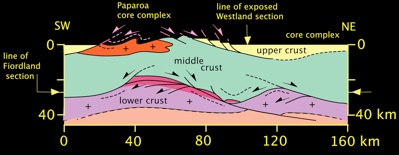Extensional Tectonics in Fiordland



Exhumed sections of the middle and lower crust show that extension initiated in the lower crust by ~114 Ma as a period of arc-related magmatism ended. Initially, deformation was localized into areas that were weakened by heat and magma. However, these hot, weak zones were ephemeral. During the period 114-111 Ma, lower crustal fabrics record a rapid progression from magmatic flow to high temperature deformation at the eclogite and garnet-granulite facies (T>700°C, P=12-19 kbar) to cooler deformation at the upper amphibolite facies (T=550-650°C, P=7-10 kbar). Lower crustal cooling and compositional contrasts between lower crustal granulites and hydrous metasedimentary material in a middle crust resulted in a mid-crust that was weak relative to the lower crust. From 111-90 Ma, subhorizontal flow and vertical thinning in a weak middle crust led to the collapse of the upper crust and the unroofing of mid-crustal material. During this period arrays of conjugate-style shear zones transferred displacements vertically and horizontally through the crust (Figure 1), resulting in a structural style that resembles crustal-scale boudinage (Figure 2). This example of continental extension shows that a weak middle crust and a relatively cool, highly viscous lower crust can result in a localized style of extension, including the formation of metamorphic core complexes that exhume the middle crust but not the lower crust.
Figure 2. Model of extension leading to the formation of metamorphic core complexes in western New Zealand. Stage shows deformation in a cooling (T=550-650°C) lower crust in central Fiordland. Formation of metamorphic core complexes that exhume mid-crustal but not lower crustal material form above a middle crust that is weak compared to the lower crust.

Selected References
Klepeis, K.A., King, D.S., De Paoli, M., Clarke, G.L., and Gehrels, G., 2007, Interaction of strong lower and weak middle crust during lithospheric extension in western New Zealand. Tectonics, 26, TC4017, doi:10.1029/2006TC002003.
Klepeis, K.A. and King, D.S., 2009, Evolution of the middle and lower crust during the transition from contraction to extension in Fiordland, New Zealand. In Crustal Cross Sections from the Western North American Cordillera and Elsewhere: Implications for Tectonic and Petrologic Processes (Miller, R.B., Snoke, A.W. eds.), Geological Society of America Special Paper 456, p. 243-265.

Figure 1. Part of an 80 km SW-NE cross section across Fiordland showing the geometry of lower crust shear zones (red). Yellow – Cretaceous high-pressure (45 m depth) granulite facies (g) orthogneiss (lower crust); Green – Paleozoic medium pressure (8-27 km depth) metasedimentary and meta-igneous rock (middle crust).